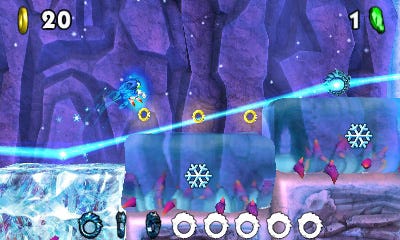What's Next for Sonic the Hedgehog (and friends)?
With a new Sonic Boom game on the horizon, Jaz talks to Sega producer Omar Woodley about the future of the franchise.
This article first appeared on USgamer, a partner publication of VG247. Some content, such as this article, has been migrated to VG247 for posterity after USgamer's closure - but it has not been edited or further vetted by the VG247 team.
Over the years, many developers have been involved in the creation of Sonic games. Which have made the very best is open to debate, but I doubt whether Sanzaru Games, who produced last year's Sonic Boom: Shattered Crystal on 3DS, would figure particularly highly in the discussion.
That game wasn't very well received by critics. However, judging by my recent visit to Sega's soon-to-be-vacated San Francisco office, it sounds like Sega and Sanzaru have been listening to the feedback. The follow-up to last year's more exploratory take on the Sonic franchise is being tightened up to deliver something more akin to what fans of the storied series are looking for.

I sat down with Sega producer Omar Woodley to talk about the upcoming Sonic Boom: Fire and Ice and find out where the new Sonic franchise is headed.
"We launched Sonic Boom as a new franchise last year with Shattered Crystal, at the same time as a new animated series that airs on Cartoon Network," says Omar. "Sonic Boom: Fire and Ice is the next episode in conjunction with the animated series."
"We're developing the game with Sanzaru Games, who also did Shattered Crystal. We think that they grasp the concept of Sonic, and what makes him unique. They also got on board with Sonic being more exploratory and having more adventure instead of that classic arcadey feel of gameplay. That's not to say we distance ourselves from that – there is quite a bit of speed in the new game, and quite a bit of the same nostalgia that's familiar, but new. But in a nutshell, this is a new franchise."

"A lot of the characters are shared between the series and the game. Sticks is the new character – she's a jungle badger. She's a bit of a hermit, but she befriends Sonic and Amy, and they help to bring her out of her shell. She's very shy and a bit neurotic, and thinks everyone is out to kill her. But she's a cool character who's very different to the other Sonic characters."
As Omar talks, he begins to play the game. Sonic Boom: Fire and Ice is a 2.5D platformer that at first glance looks like a classic Sonic the Hedgehog game. The graphics are a little less arcade-like, and not quite as vibrant as the early games, but it still retains a quintessential Sonic feel.
Omar addresses player reaction to Sonic Boom: Shattered Crystal. "With our previous game, it was a kind of a shock to the fanbase how we designed it. There was more focus on exploration and less focus on speed. We've toned down on the exploration and put a bit more speed into Fire and Ice. In the previous game we dropped you into this enormous labyrinth, a Castlevania-style level design. Sonic fans were like, "What is this? I just want to run through and hit bounce pads and spring boards and speed boosts and ping-pong around." So we've dialed down the length and the size of the levels and cut a linear path through the middle. The exploration now happens above and below it. So now you can have that classic experience of running through the level at high speed if you want, but now you can also explore too."
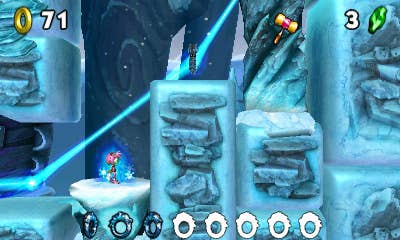
"There are a lot of collectibles in the game too, which is tied up in the exploration aspect of the game – they all unlock stuff like characters and bonuses. We have seven islands in the game, six of which are exploration-based and feature four levels plus two bonus stages. Then the seventh is called Thunder Island. This is new to 3DS and the Sonic Boom franchise, and it's basically a two-player local play option that is based on a race between Eggman's bots."
"Basically, Eggman has found a new element called Ragnium, which he melts down and combusts as fuel. These bots, which are henchmen in the animated series, have been brought into this game as rival racers. Eggman's goal is to humiliate Sonic by making bots that are faster than him. Of course that whole plot fails… but to do that you need to beat all the bots in the game to prove Eggman is wrong – there's one on each island. As you progress, you unlock character bots that can then be used to race your friends in local play on the crazy courses we've designed."
"The main story follows a henchman called Defect. He's been designed by Eggman to find Ragnium and mine it. He has these eco magnets that are supposed to enable him to raise it out of the ground. However, when Eggman turns him on, it totally fails – which is why he's called Defect. However, it turns out that he can magnetize everything other than Ragnium, so he begins to use his powers to build himself up so he can beat Sonic. Also, part of the storyline is that as Eggman collects Ragnium, he's polluting the environment. So part of the game is restoring the environment – which is an homage to the original Sonic games."
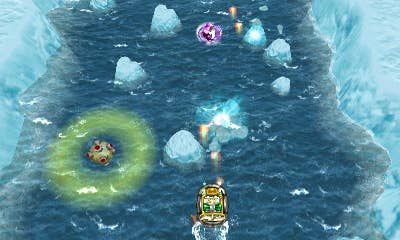
"The adventure stages are the main levels of gameplay through the game. There are four per island, and you can use each of the game's characters in every level. Each character has his or her own special powers and there are setups in the game where you need to use all of them at some point. You can switch between them on the fly by using the touch pad. Sonic can jump higher than all the other characters, and has a special air dash. New to the cast is Amy, and she has a hammer that can break things and alter the terrain of a level. Tails returns and he's the gadget guy. He can hover and fly by using air streams, plus he also has a blaster that can reflect off mirrors. Knuckles can punch stuff, and can also burrow underground and reach parts of the landscape no other characters can access. Sticks has a cool boomerang that you can take control of and guide around so it can hit things that might be around corners."
"Also, every character has fire and ice abilities that can be used to freeze water so you can walk over it. There are setups where ice blocks are in the way that you can melt to go through, or water spouts that you have to turn into ice so you can run across them. In some situations you have to change from fire to ice ability very quickly. It can be very fast – almost like changing gear in a racing game."
At this point Omar reaches one of the game's Challenge Rooms. These are designed specifically for hardcore Sonic fans. He explains, "You don't have to complete the Challenge Rooms to finish the game, but you have to finish them if you want to get 100% completion. They're basically optional, but they have some really cool setups. More seasoned gamers will have a lot of fun with them."

The room Omar showed me had Sonic grinding down a rail, reminiscent of Sonic Adventure 2 on Dreamcast.
As Omar plays the game, I note that much of its challenge seems to come from environmental puzzles – jumping over gaps and using the fire and ice abilities to avoid hazards. He agrees. "Most enemies in this game aren't that aggressive – they're not really there to chase you around and confront you. They're mostly there to assist with you with the rhythm play so you can bounce off them. But there are a few oddballs in there that will chase you – so you have to be careful when you're bouncing off enemies because some will come after you."
Of course there are bosses too. Omar reveals, "There are four in all, and we did something unique with them – they use both of the 3DS' screens so they're basically two screens high. You're always going to be Sonic in a boss fight, but for each fight you're paired with another character so you can use their special abilities."
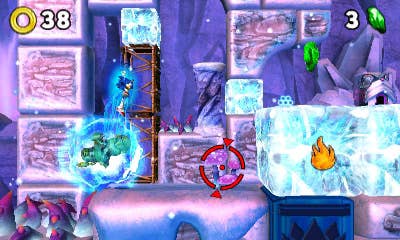
Each boss fight sees Defect using items from the environment to construct a giant monster. In the boss fight Omar demoed, Defect was driving a large creature made out of tar and dinosaur bones, which attempted to smash Sonic at the bottom of the screen. Tar flowed out of the ground that Sonic had to avoid stepping into, and then Defect blew tar bubbles, which companion character Tails was able to dodge by floating over. Once they were safely negotiated, the creature was momentarily vulnerable to attack. It was classic gaming pattern-learning stuff, and looked like fun.
After the boss fight, Omar switched to a bonus area that takes the form of a classic 3D tunnel run from Sonic 2, where you're running down a tube collecting rings and dodging hazards. Apparently there are twelve of these in Fire and Ice.

There are also two other types of bonus levels. One features the Sea Fox submarine from Game Gear Tails Adventure, where you float around shooting at things with your sub while looking for collectibles. This part of the game feels quite serene and calm, and is a nice change of pace from the more hectic main levels. There's also a hovercraft game where you're racing up the screen trying to avoid or blast icebergs. Again, there are collectibles to pick up.

Demo finished, I am quite impressed. It's hard to judge a game just by watching, but my immediate impression of Sonic Boom: Fire and Ice is that it seems to be a lot more immediate and direct than last year's more labyrinthine and much slower-paced game. Basically, you can play the game more like a traditional high-speed Sonic platformer. The more exploratory and adventure aspects are optional detours this time around.

I ask whether this new Sonic game represents the future of the franchise. Omar explains, "Sonic Boom is meant to branch away from the classic/legacy Sonic. Our plan is to go forward with both the modern Sonic and the legacy Sonic, but the Sonic Team will handle the legacy side of things in Japan. For us, the Western initiatives will tie into the toys, merchandizing, animation – movies potentially even. We're branching out into the more upbeat adventure style theme for Sonic Boom."
He continues. "Our main target audience is 7-11, but what we saw when we released the first game is that Sonic fans picked it up. That's a challenge: you've got your older audience and younger audience, but the older fans had a harder time getting into it, because it they're so used to classic and legacy Sonic, and that's what they thought Shattered Crystal was going to be."
"It can be tricky sometimes. You're developing a game that is for an intended audience, but we have a legacy group of people that played the Genesis and Megadrive games. Then you have the audience that played the Dreamcast and GameCube era games. Then you have the modern, younger audience. Each of these three groups is looking for something slightly different. Our challenge is how do you make a game that appeals to everybody. That everyone can play and say, "I like this." That's the challenge we're working with."
In terms of the future, it seems that Sonic will essentially have two lines. "We have all the Sonic Boom stuff, but we also do classic lines of stuff," explains Omar. "There's all sorts of merchandizing that's designed to appeal to the older audience and the younger audience. When we first announced the Sonic Boom initiative, the fans were all, "why is Knuckles so big, and why does Sonic have a scarf". All these little things. But we said, "don't worry, we're not taking the old Sonic and getting rid of him." The original Sonic design is still here and he's here to stay. They're just two separate universes that are running parallel to one another."
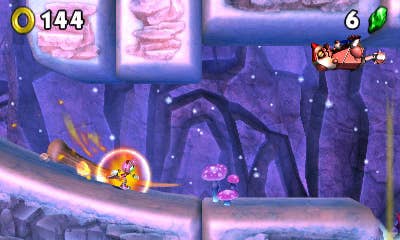
"We're thinking bigger than just the video game. We want to branch out into the Western market a bit more and update Sonic's look and appeal to a younger age group – the new gamers. And so we wanted to do something exploration-based. We didn't want to just reboot the classic series. We wanted to do something new – and not alienate the classic players."
However, Omar is quick to admit that the first iteration wasn’t perfect. "I think we went a bit too far with the exploration in the last game. There were a lot of speed runs and rhythm play sections, but they were so spread out you lost that speed aspect of the game. That was one of the big things that people complained about – "if you slow down Sonic, it doesn't feel like Sonic." Now we're trying to fix that. We want to keep what's going on in the animated series, the adventure and exploration, but we also want to keep the feel of classic Sonic. So now we've made the levels smaller, and cut a linear path through them, and plugged in all the classic Sonic pieces, and now the game feels more like the classic game."
Of course, without playing it myself, I can't definitively say whether Fire and Ice truly feels like a classic Sonic game, but it's certainly looking promising – and very different from last year's game. We'll be able to find out just how good it is when it's released at the end of this year.
